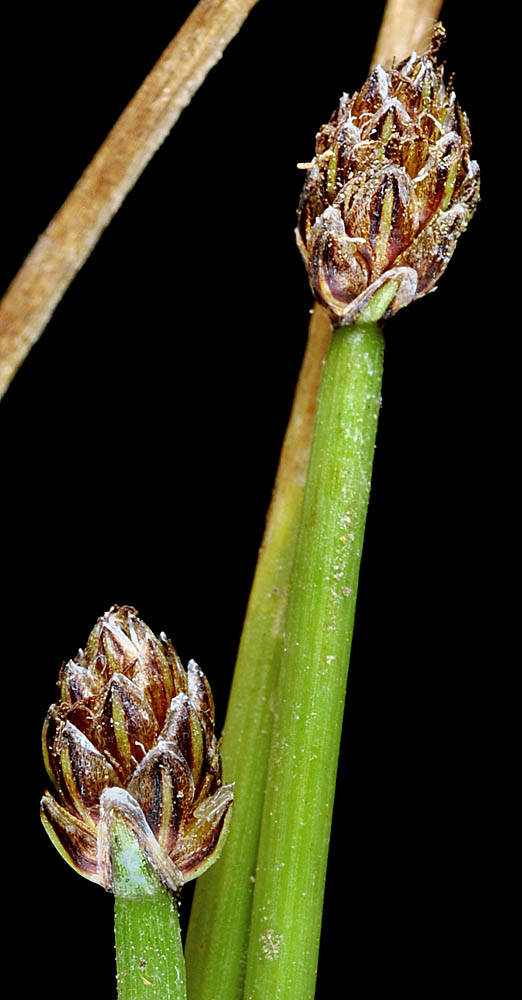
Plants annual, tufted.
Culms terete, 3–50(90) cm × 0.2–2 mm.
Distal leaf sheaths persistent, apex of distal leaf sheath obtuse to acute, tooth to 0.3 mm.
Spikes usually broadly ovoid, (2)5–13 × (2)3–4 mm; floral scales 15–150+, 8–20 per mm of rachilla, 1.5–2.5 × 1–1.5 mm, apex broadly rounded.
Flowers perianth bristles (5)6–7, rarely 0, slightly to usually greatly exceeding tubercle; stamens (2)3, anthers 0.3–0.6 mm; stigmas usually 3 and 2 in the same spike.
Achenes biconvex or to 33% greatly compressed trigonous, 0.9–1.2(1.3) × 0.7–0.9 mm.
Tubercles deltoid 0.35–0.5 × (0.4)0.5–0.8 mm, 33–50% as high as wide, 33–50% as high and 67–90% as wide as achene.
2n=10.
Freshwater shores exposed by seasonal low water levels, marshes, and disturbed wetlands. 0–1300 m. BW, Casc, Col, CR, ECas, Est, Sisk, WV. CA, ID, WA; north to British Columbia, east to Nova Scotia, southeast to FL, HI. Native.
Eleocharis obtusa is our most common tough, annual, cespitose spikerush. It is sometimes considered to be the same species as E. ovata, which generally has two stamens and two stigmas and has narrower tubercles. See also E. engelmannii.
as described under Eleocharis obtusa
Culms 3-50(-90) cm × 0.2-2 mm. Leaves: apex of distal leaf sheath obtuse to acute, tooth to 0.3 mm. Spikelets broadly ovoid (to ellipsoid or lanceoloid), apex rounded (to acute), (2-)5-13 × (2-)3-4 mm; floral scales 15-150+, 8-20 per mm of rachilla, orange-brown (to stramineous), elliptic, 1.5-2.5 × 1-1.5 mm, midribs seldom keeled, apex broadly rounded. Flowers: perianth bristles (5-)6-7, rarely 0, brown, stout, slightly to usually greatly exceeding tubercle; stamens usually 3; anthers brown to yellow, 0.3-0.6 mm; styles usually 3-fid and 2-fid in same spikelet. Achenes 0.9-1.2(-1.3) × 0.7-0.9 mm. Tubercles deltoid 0.35-0.5 × (0.4-)0.5-0.8 mm, 1/3-2/3 as high as wide, 1/3-1/2 as high and 2/3-9/10 as wide as achene. 2n = 10.Fruiting summer-fall. Fresh shores, marshes, disturbed places; 10-1600 m; B.C., N.S., Ont., P.E.I., Que.; Ala., Ark., Calif., Colo., Conn., Del., D.C., Fla., Ga., Idaho, Ill., Ind., Iowa, Kans., Ky., La., Maine, Mass., Mich., Minn., Miss., Mo., Nebr., N.H., N.J., N.Y., N.C., Ohio, Okla., Oreg., Pa., R.I., S.C., Tenn., Tex., Vt., Va., Wash., W.Va., Wis., Wyo.; Pacific Islands (Hawaii).Extremely uncommon plants of Eleocharis obtusa without perianth bristles may be called E. obtusa var. peasei (type from New Hampshire). Robust plants with distinct caudices, floral scales 2.5 mm, and achenes 1.2-1.3 mm (Eleocharis obtusa var. gigantea Fernald) are rare (specimens seen from the Washington-British Columbia border [type], Arkansas, and the Hawaiian Islands). Dwarf plants (E. obtusa var. jejuna Fernald, type from Maine), with unusually small achenes and floral scales, and tubercles often less than 0.5 mm wide, are occasional in the East and are easily confused with E. ovata and E. aestuum. A few specimens are intermediate with E. engelmannii. Eleocharis obtusa is sometimes treated as conspecific with E. ovata, which consistently differs in its mostly 2-fid styles, mostly two stamens, and especially its narrower tubercles (B. M. H. Larson and P. M. Catling 1996).Eleocharis macounii Fernald has been treated as a synonym of E. obutsa (H. K. Svenson 1957) but is more probably a hybrid between E. intermedia and E. obtusa (P. M. Catling and S. G. Hay 1993; see 34. E. intermedia).